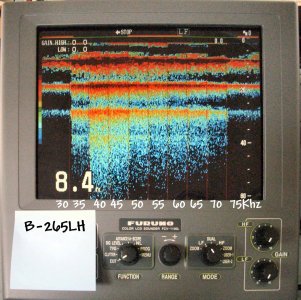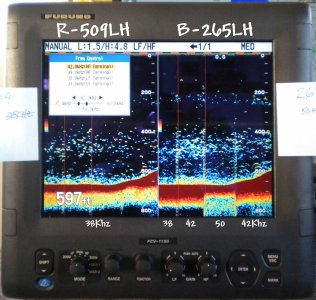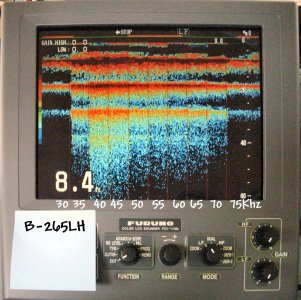Good morning Adam,
Thank you for your inquiry. As you have probably researched the FCV295 has a Free Synthesizing Transceiver which allows you to choose different frequencies to transmit at. This is a manual process but pretty easy to do after a little practice. Please keep in mind that the FCV295 does have some frequency ranges that it cannot transmit at. The frequency ranges the FCV295 cannot transmit at are the following: 53-65 kHz, 111-139 kHz, and 171-183 kHz. When looking at chirp transducer bandwidth please keep these frequencies in mind because you will not be able to adjust the 295 to transmit within those frequencies. The Airmar TM265LH is a 1kw transom mount transducer that is Chirp capable. Meaning the elements are designed to be efficient at multiple frequencies. The stated bandwidth of the B265LH works on lower frequencies at 42-65 kHz and higher frequencies 130-210 kHz.
Typically the rule of thumb to go deep with a CW (continuous wave) sounder is a factor of two principles, output power and frequency, with frequency really playing a more important role. Really to go deep you want to look at lower frequencies, the lower the frequency the deeper you go. If you increase the output power with lower frequencies then you have a true deep drop machine.
Some other questions to consider include what type of fishing you do. Transducer beam width can play a big role in your decision. For example if you are targeting pelagic species you will probably want to find a transducer that has a wider beam angle so you can cover more water, it will also stretch your fish targets on the machine because with a wider beam angle the fish stay in the beam longer extended the marks on the screen. If you are trying to focus on bottom fishing especially looking for structure and wide beam and a narrow beam is a good combination. The wide beam lets you find the structure and the narrow beam allows you to pinpoint where that structure is and stay on top of it. The TM265LH at lower frequencies has a beam angle 25-16 degrees with the wider beam at the lowest frequency. The higher frequency beam angles range from 10-6 degrees with the smallest beam angle at the highest frequency.
As you mentioned below, your only option is a transom mount transducer, this will limit your options regarding transducer choices, but it is what it is. Fish detection with the TM265LH with low frequency is going to be pushing the envelope at 1500ft. There is no doubt the sounder and transducer combination will find bottom at that depth but your fish detection at that depth is going to be pushed. We perform sweep tests with different transducers when they become available. When we did a sweep test of the B265LH, same elements as a TM265LH, we found the strongest returns around 42 kHz on the low side and around 135 on the high side. Please see picture below.

If you do go with that transducer to get the best results deep you will want to be around the 42kHz frequency.

The FCV295 requires a non-diplexed transducer. It would not require additional components to work with the TM265LH or LM.
The FCV295 has the ability to output a TLL when it is fed position from a NMEA0183 device. The plotter would require the ability to use a TLL NMEA0183 sentence.
If you do not plan on using the frequency ranges the TM265LH has to offer you might consider a TM260 non-diplexed transducer which is less expensive. Although the TM260 is locked into specific frequencies at 50 kHz and 200 kHz I don't believe you will see a loss of performance. However if you plan to add a chirp sounder to your vessel in the future the TM265 might be the way to go.
Please keep in mind the TM260
Ultimately you are limited to choices because you can only use a transom mount transducer. So larger output power and other frequency transducers are limited.
C-Bass







